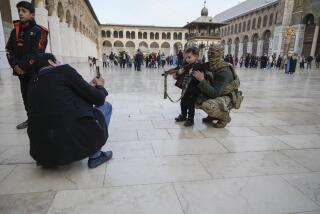U.S. would rely on missiles in a strike on Syria
- Share via
WASHINGTON — A U.S. attack on Syria is likely to begin at night with fiery explosions at military installations, artillery batteries and headquarters near the capital, Damascus, and other government strongholds around the country, according to current and former U.S. officials.
The strikes, involving dozens of cruise missiles launched from U.S. warships, attack submarines and possibly warplanes, would probably last up to three days. The Obama administration is seeking to punish President Bashar Assad’s government for its alleged use of chemical weapons while avoiding a messy intervention in the country’s civil war.
U.S. planners expect Syria to activate its sizable air defense system once the attack commences, firing antiaircraft guns and surface-to-air missiles into the night sky in an effort to shoot down the low-flying Tomahawk missiles whizzing over buildings and mountains at more than 500 mph. Most of the weapons are likely to get through, though, because the U.S. will be jamming Syrian radars, analysts say.
With diplomatic efforts still underway, President Obama said Wednesday that the United States had concluded the Syrian government was responsible for a chemical weapons attack last week in Damascus suburbs. He insisted he has not decided whether to authorize an attack, but a strike on Syria appears likely.
The United States has a clear interest in responding to use of chemical weapons to deter further use and to keep them from terrorists, he said.
Syria is a “volatile country in a very volatile region,” Obama said on PBS’ “NewsHour.” He noted its proximity to Israel, Jordan and Turkey, all key allies, as well as U.S. bases throughout the region.
“Then there is a possibility in which chemical weapons … could be directed at us,” Obama said. “We want to make sure that that does not happen.”
If Obama decides he wants more targets destroyed, some analysts say, the Pentagon may also employ warplanes, which can fire additional cruise missiles and other munitions from outside Syrian airspace. It could also send stealth bombers over Syria to destroy an important target while seeking to avoid civilian casualties.
The relatively brief air campaign under consideration is unlikely to inflict major damage on Assad’s considerable conventional forces, and it would not seek to destroy dozens of widely dispersed sites where chemical weapons are stored, out of concern that doing so could release poisons or leave the sites open to looting.
Instead, planners at the Pentagon’s Joint Staff and U.S. Central Command, which will oversee the attack, have presented the White House with a target list that includes some of the Assad government’s most loyal military units, including those believed to have been involved in the Aug. 21 suspected chemical attack that is reported to have killed hundreds, one official said.
“They want to send a signal that those units are being targeted as much as possible because of their specific involvement” in the chemical attack, said one military official.
But planners are also worried that, as administration officials have signaled an attack is imminent in recent days, the Syrian military has begun dispersing its forces in order to protect them, raising the likelihood that the bombardment could hit facilities and installations emptied of troops and equipment, one official said.
Jeffrey White, a former Defense Intelligence Agency officer and a fellow at the Washington Institute for Near East Policy, said the U.S. knows headquarters and barracks locations of Syria’s 4th Armored Division and Republican Guard units, which may have been involved in the chemical attack.
“I think we can target their facilities right now,” he said. “If they have moved, it’s harder.”
Central Command has significantly boosted satellite and other types of surveillance of possible target areas in Syria over the last two weeks in order to track government attempts to move its forces, one official said.
Along with units suspected of involvement in chemical attacks, the strikes are expected to target artillery units that can fire munitions carrying chemical agents or conventional explosives, as well command facilities and bunkers, a military officer briefed on the planning said.
Obama needs “to find the right target set that will be punitive and that will have a strong deterrent impact on Assad’s potential future use of chemical weapons,” said Rep. Adam B. Schiff (D-Burbank), who sits on the House Intelligence Committee. “But at the same time it should not go so far beyond the instrumentalities of chemical weapons use that it appears we’re trying to topple the regime.”
The Tomahawk cruise missiles that the Pentagon is planning to use have a range of nearly 1,000 miles, allowing them to be fired from U.S. warships hundreds of miles off the Syrian coast, well beyond the range of antiship missiles.
Four U.S. guided-missile destroyers — the Ramage, the Gravely, the Barry and the Mahan — are now in the eastern Mediterranean, each carrying up to 90 cruise missiles. In practice, said Christopher Harmer, a retiree Navy officer and former operational planner in the Middle East, most are probably carrying about 45 missiles. They carry a relatively small, 1,000-pound warhead.
Nuclear-powered attack submarines that can also fire Tomahawks are likely to be in the Mediterranean as well. Some submarines carry only a dozen cruise missiles, but some specially configured Ohio class subs carry up to 154 of those.
Even without an Ohio class submarine within range of Syria, the Navy could fire about 200 missiles. Harmer, an analyst with the Institute for the Study of War, said that “is more than enough to conduct a medium-intensity strike against a variety of targets.”
British submarines also carry cruise missiles and joined the U.S. in firing them during the 2011 war in Libya that ousted Moammar Kadafi. But it is unclear whether Britain is planning on joining the U.S. in striking Syria.
With U.S. forces likely to stay well outside Syria, the Assad government’s ability to strike back is severely limited, according to current and former U.S. officials. Antiaircraft fire might succeed in hitting some of the cruise missiles, but Syria’s air defenses are likely to be overwhelmed. Cruise missiles can be programmed to take routes that avoid air defense sites.
“If you put up enough flak, you might get lucky,” said White, the former defense intelligence officer. But “most of the cruise missiles will get through.”
Times staff writer Christi Parsons contributed to this report.
More to Read
Sign up for Essential California
The most important California stories and recommendations in your inbox every morning.
You may occasionally receive promotional content from the Los Angeles Times.












